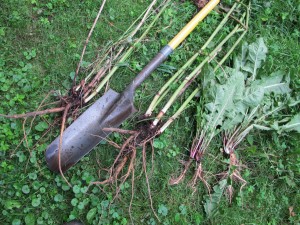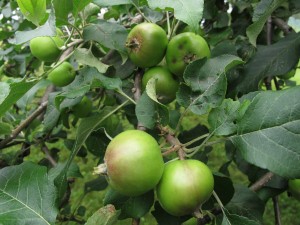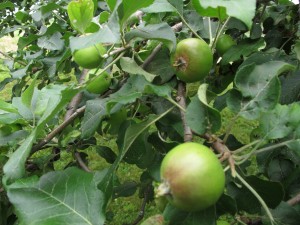Early Summer Chores in the Vegetable Garden
I don’t recall ever hearing a version of George Gershwin’s song, Summertime, that I didn’t like. But I’m not sure about the accuracy of that line “and the livin’ is easy.” Right now I have a lot to do in the garden.
Let’s start off in the vegetable patch. I’ve had a lot of rain in the last 3 weeks, so everything has been quite happy – especially the weeds. Of course since the soil is moist, weeds are pretty easy to pull. But still, I do not just pull weeds. Yank on the top of a weed, especially a big perennial weed like a dandelion or a burdock, and it breaks off. The roots stay behind to produce the leaves all over again. Sisyphus, the Greek who kept pushing the boulder up a hill in mythology, could have been a gardener – without a good weeding tool and proper technique.
In order to keep weeds and grasses from re-sprouting, you need to get the entire root out. After all, they evolved with herbivores that not only bit off their stems, but often gave a good yank. To survive, they must re-sprout from roots. So learn to know your weeds and their root systems. To remove a weed with tap root, you need to loosen the soil. In general, the bigger the plant, the longer the root.
Dock (Rumex spp.) is a big, tall weed that loves my garden. It has a root that can go down more than a foot. If the soil is loose, moist and fluffy I might be able give a long slow pull and remove all its roots. But in dry or compacted soil, I need to use a drain spade (mine is pointed and its blade is 16 inches long by 5 inches wide) or a garden fork to loosen the soil before pulling. I plunge it deep into the soil a couple of inches away from the weed, and pull back to loosen the soil. Of course, the blade may sever a side-root if I am not careful.
For ordinary weeds I use my CobraHead weeder, which is a like a steel finger, curved and sharp. I can get it under a clump of grass or weed and loosen the soil before I begin to tug from above. It’s very effective, especially to tease out long roots of invasive grasses.
I recently weeded my onion patch. Onions hate weeds – in part because weeds steal their moisture. After weeding, I soaked a pile of newspapers and then spread them out alongside the onions and in the space between my double rows. I didn’t put newspaper between the individual onions in their rows, as they are too close together and it would have been too much trouble. I spread mulch hay over the newspaper to keep it in place. The newspaper smothers any seeds that might germinate and try to grow after my late-June weeding.
When I give lectures on gardening, I tell my listeners that they must thin their beets and carrots on the Fourth of July at 10am. Or around that time. Carrot seeds are tiny and most of us manage to plant too many, too close together. And we all hate killing baby carrots. But if we don’t thin them, the carrots will compete with their kin for water and soil nutrients – just as weeds do. Thin them now, today, to one-inch spacing. A few companies (Johnny’s Seeds is one) sell pelleted seeds that are sold covered with a layer of clay, making the seeds a size you can handle and plant individually. Look for them.
Beet seeds are not seeds at all, but seed capsules. So no matter how carefully you spaced the “seeds”, you must thin them now as usually 2 or 3 plants start from each seed capsule. There are a few varieties like ‘Moneta’ that have just one seed per capsule, so you can avoid thinning.
This is also a time to start second (or third) plantings of lettuce and other greens. I’m eating my first crop of lettuce and new plantings will help to keep the salad bowl full all summer. I’ll plant a few seeds every 2-3 weeks. You can plant a second crop of broccoli from seed now, too. That will mean that you get big juicy heads of broccoli in September and October.
This spring my apple trees produced more blossoms than usual. That means that there will be huge numbers of apples, come fall, but that each will be smaller – unless I take action. A tree can support just so much fruit. Thinning out – removing fruit – will promote bigger apples. I should have already thinned my apples by now, but it will be all right to do it now. See a clump of apples? Leave just one or two and remove the rest. I’ve read that it’s good to space apples 4 to 6 inches apart on a branch by thinning. Thinning will also help to minimize the alternate-year pattern for big fruit loads that are common with some varieties.
You can also put paper bags over some apples (and tie off the bags with twist ties) to have a few apples
that are perfect and unblemished. If you’ve had trouble with apple maggots in the past, buy a few fake red plastic apples at the garden store, and cover them with a sticky substance (one brand is called Tanglefoot and is suitable for use by organic gardeners). This will catch the moths that are attracted to the redness of the fake apples – moths are not too bright.
So use your weekend to get caught up on some gardening chores. And okay, take some time off to snooze in the hammock if you must.
Henry Homeyer is the author of 4 gardening books and a new fantasy-adventure for children about a boy and a cougar. His web sites are www.henryhomeyer.com and www.Gardening-Guy.com.






